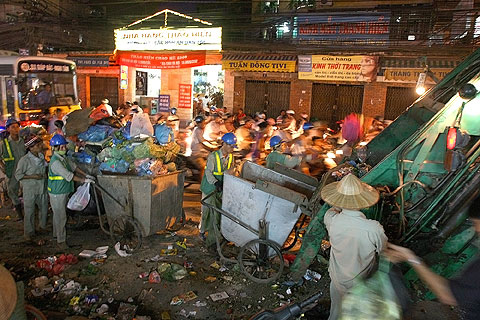Sort garbage by semi-automatic line
The domestic solid waste treatment line researched and manufactured by Ho Chi Minh City University of Technology has overcome the habit of not separating waste of many households.
Accordingly, all kinds of organic waste such as vegetables, rags, leather, wood . until inorganic garbage such as glass, debris, metal . are separated.
Sort garbage by machine
Engineer Tran Hung Dung, Department of Machinery and Equipment, Department of Chemical Engineering, Ho Chi Minh City University of Technology, said: To classify this mixture of waste, the research team chose to use hydraulics combined with aerodynamics. .
In principle, by hydraulic and aerodynamic methods, organic waste will emerge while heavier inorganic waste will sink. With this method, garbage is separated into different groups, making recycling easier.

Most waste is not classified.
Besides, this new technology line also takes advantage of most solid waste for recycling. For example, all kinds of organic waste (vegetables, tubers, fruits .) after being processed will be recycled into micro-organic fertilizer, nylon garbage and rubber will be recycled into petroleum, recycled paper turning back into pulp, debris into bricks, glass and metal are sold to specialized facilities.
Mr. Do Trung Nam, Deputy Manager of Technology Management Department, Department of Science and Technology of Ho Chi Minh City, said: In the past, many foreign organizations funded the city to classify garbage for processing into composit and re-compost. but ultimately failed because people's consciousness of waste classification was still low. The technology line for solid waste treatment is researched by Ho Chi Minh City University of Technology, which is quite suitable for recycling plants in Vietnam.
However, Mr. Nam said that this still needs workers in some stages to classify that this line is not complete.
Waste should be treated instead of buried
Recently, in the process of socializing waste treatment activities, some investors have 'tried' in the field of waste treatment. Thereby, open up some other more modern ways of processing such as recycling, composting, burning garbage and converting into electricity .
However, so far, measures to treat domestic waste in HCMC are mostly burial. This is clearly not the optimal solution because it costs a lot of land.
In fact, HCMC has stopped receiving garbage at Go Cat landfill (Binh Tan District) and Dong Thanh landfill (Hoc Mon District) because of the overload condition here.
In addition, with landfill treatment, leachate sources can contaminate soil and water sources below it. In addition, there is a risk of air pollution and not taking advantage of economic resources because they are not recycled .
Therefore, according to the research team, at present, this new technology line is interested by some businesses in Ho Chi Minh City and Tay Ninh, preparing to deploy investment for their facilities.
Statistics of the functional industry, the volume of domestic solid waste collected and processed in HCM City continuously increased. In 2006, the volume of domestic solid waste collected was over 1.8 million tons / year, an increase of 8.6% compared to the same period in 2005.
2007 increased by 3.2%. By 2008, the number increased to below 4%. In 2009, although there was no official statistics, only the amount of garbage collected in the first 4 months of the year exceeded 710,000 tons, ie nearly 50% of the whole year 2006.
HCM City Department of Natural Resources and Environment predicts: By 2010, the amount of domestic waste in the whole area will be at 7,000-7,500 tons / day and reach a milestone of around 16,000 tons / day for 10 years next.
- Feast your eyes on the automatic fish fillet line with incredible precision
- How to sort garbage at home, you know?
- Launched super cooking robot as chef
- Semi-automatic sprinkler by homemade farmers
- The student group's friendly 4.0 trash can help sort out the garbage correctly
- Smart guns turn ordinary people into gunners
- Huge ocean garbage collection system
- Robot: Future warrior of the US military
- Automatic machine picks up garbage on the water
- 'Auto sweeper' model
- Automatic equipment for garbage collection on the river
- View Tesla Semi trucks rolling first in the street
 Is the magnetic North Pole shift dangerous to humanity?
Is the magnetic North Pole shift dangerous to humanity? Washington legalizes the recycling of human bodies into fertilizer
Washington legalizes the recycling of human bodies into fertilizer Lightning stone - the mysterious guest
Lightning stone - the mysterious guest Stunned by the mysterious sunset, strange appearance
Stunned by the mysterious sunset, strange appearance